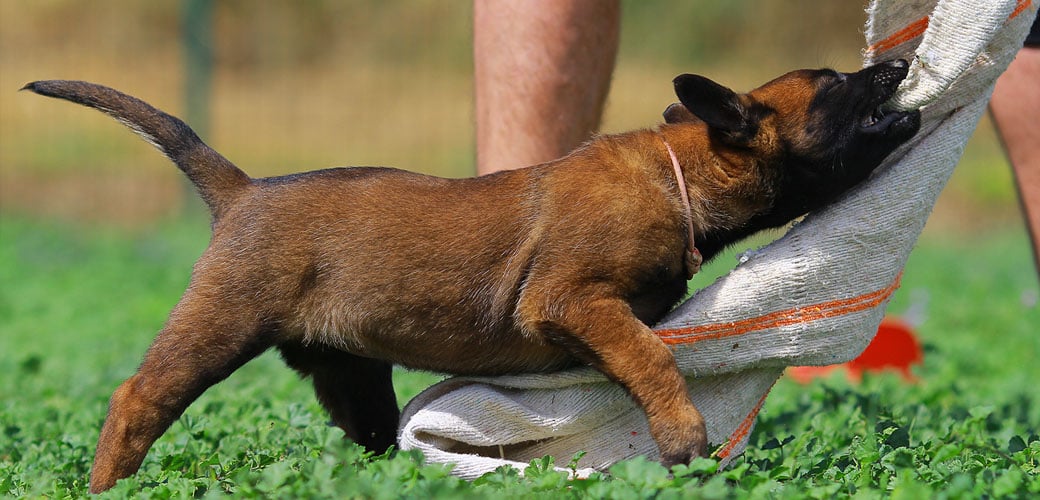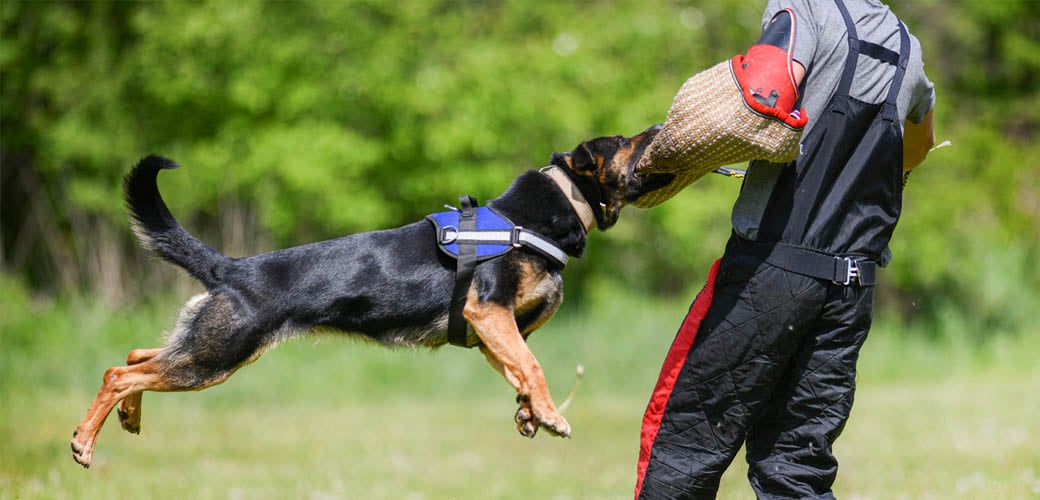
What is Bitework?
October 29, 2022
Bitework training means teaching a dog to bite, usually on command, but sometimes also in response to specific threats. This type of training is useful for police dogs, as well as guard dogs, and dogs that compete in sports like Schutzhund, French Ring, or Mondio.
Not all dogs are suitable for bitework training. This type of training can be seen by some dogs as very stressful and scary, and most dogs that do it successfully have been bred for it and trained from a young age. This isn't to say that an adult dog can't start doing bitework, it just depends on the individual dog and your goals as a dog owner.
When to Start
Believe it or not, bitework training can start as young as 8 weeks old — where it is often called “ragwork” — because puppies are typically taught to first bite and chase a piece of leather or even an old towel or “rag", hence the name. However, bitework training can begin at virtually any age, depending on factors like your dogs breed, demeanor, confidence level, and drive
to chase.Most dogs that are referred to as "high-drive" naturally enjoy games of chase and will play with a ball or toy nonstop. Dogs that exhibit these traits are usually ideal candidates for bitework training because their innate desire to chase makes the training very enjoyable for them, and it takes little from the handler to bring out their natural instincts. Drive can be ranked from low to high, meaning a dog can have a low natural desire to do certain things, or a very high one - from a young age, without any special training.

A Belgian Malinois puppy learning ragwork with a helper
Finding a Helper
Possibly the most important rule when teaching your dog to bite on command is that the dog is never supposed to bite you, or the people in your household, so working with a qualified helper, professional dog trainer, or dog club is a critical component of this type of training.
Broadly, a helper refers to the person who is wearing the bitesuit or sleeve, and engaging with your dog during training - but in practice, helpers can be mentors for both you and your dog, and will ultimately have the most responsibility in how your dogs training progresses (besides you!) Finding a helper typically starts with searching for local Schutzhund clubs or a professional dog trainer in your area who has experience with bitework training.
Like all dog trainers, helpers have varying levels of experience and use many different training techniques, so finding the right helper for you and your dog can take some trial and error. It's a good idea to reach out to a few clubs or local trainers and ask them about their methods before starting any training with your dog. Some good questions include:
- How long have you been doing helper-work?
- When did you last title a dog in Schutzhund, KPNV, or equivalent dogsport?
- Where did you learn helper-work?
- Can you show me videos of you working dogs, or can I sit in on a session with someone elses dog?
It's not rude to ask questions, especially when you are trying to decide on whether or not you should work with a certain trainer. Even so, it can be difficult to guage a helper on their responses to these questions alone. There's no substitute for doing research and asking around your local community for their opinion of a certain trainer. Having the insights of a helpers other clients or club members can even help you understand the pros & cons of their training techniques even better.
Owners that are considering bitework training for their dog should focus on providing plenty of socialization with people and other dogs, as well as teaching obedience commands like sit, down, come, and stay. Your dog should be social, friendly, and well-rounded before starting bitework training. Dogs that growl or bark at new people might seem like good candidates for bitework training, but they generally lack confidence, and this type of training can stress them out and make their undesirable behavior even worse.

Helper wearing a bite sleeve working a German Shepherd Dog
Training Gear
Unlike basic obedience training, bitework training can get expensive very quickly, as you will need special tools to support your dog throughout his training. For example, when your dog is young, he may need an agitation harness to help encourage him to bite, by letting him pull against the leash without accidentally correcting him. As he gets older, you may switch to an agitation collar to challenge your dog to pull against his collar, even though it is much less comfortable.
Popular reward toys, like hard rubber balls on a string and bite bars are not typically sold at your local pet store, nor are common training collars such as fur saver collars, so be prepared to have to search online if you're interested in getting started with this type of training. When getting started, most people need:
- 6' leash
- 12' or 20' long line
- Agitation harness (and/or collar)
- Toy to reward your dog with, such as a ball or tug
- Fur saver collar, (or other mild collar)
While you don't have to invest in your own bite sleeves or bite suits, some people choose to. Most of the time, the purchase of this gear is left to trainers or dog professionals, as it's very expensive ($200-$2,000) and impractical to own yourself, since you can't use it!
Dog Breeds
Many breeds of dogs (even chihuahua's and french bulldogs) can do bitework. However, the most common breeds of dogs descend from long bloodlines of dogs that have done this type of training in the past, making it much more likely that they will excel. These breeds include:
- German Shepherd Dog
- Belgian Malinois
- Bulldog
- Rottweiler
- Doberman Pinscher
The most common requirement in a dog that is trained in bitework is that the dog is big enough to stop an oncoming threat. So although little dogs often enjoy the training, they're impractical to compete with or for use in military & police work because of their small size. On the other hand, dogs that are too big can pose a hazard to themselves during training, because it is so rigorous that giant dogs can easily get hurt or prematurely develop joint conditions. Most dogs that compete, work as personal protection dogs, or have military jobs are between 40-80lbs.
Does Bitework Make Dogs Vicious?
Bitework training takes the natural desire an individual dog has to chase, bark, or bite things (instincts which all dogs evolved with, to some degree) and provides a controlled outlet for them. Bitework can make a dog who is otherwise bored and aggressive more tolerant of stressful situations, and less likely to be triggered by events around the house or in public. Bitework teaches dogs impulse control, patience, and focus, and allows your dog a rigorous workout unlike simply throwing a ball.
However, bitework training is not something to be undertaken lightly. Teaching any dog that it's OK to bite a person requires committed management of the dogs training and day-to-day activities for the rest of its life.
This often means compromises in your own life, such as finding specialized dog boarding if you plan on going out of town, making sure the dog is not out when contractors are coming to your house, and building a relationship with your veterinarian and other animal caretakers early in your dogs lif to ensure your dog can be safely seen for health checkups, grooming, or dog walking.
If your dog is already displaying aggressive behavior, he may not be suitable for bitework training because reinforcing this behavior could make the impulse to bite stronger. As with anything, it all depends on the dog, your specific goals, and your ability to dedicate time to training. For many dogs, bitework can be compared to a game of tug of war, where the dog is just getting rewarded and having fun and there's very little stress involved at all. In these situations, your dog is not seriously defending you and may never draw the connection between biting a sleeve, and biting a real person.
If your goals are to do personal protection training or compete in a dog sport like Schutzhund the best thing you can do is find a working dog club or professional trainer in your area who can help guide you. Bitework training is a long, multi-year journey, and can take as much of a time commitment as any other hobby. Having people around to support you and spot you
will be essential as your dog learns and graduates to progressively more difficult exercises.






